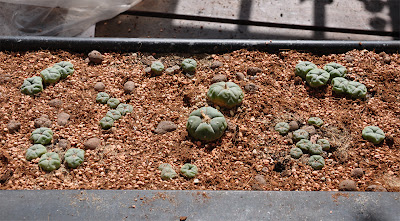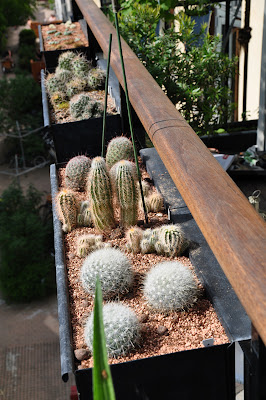
Snow covered cacti growing in window boxes
As mentioned in an earlier post I'm experimenting with growing peyote (and other cacti) outdoors on my balcony. A month or so ago I chickened out and moved the window box with peyote and Acharagma to the attic in order to shield it from precipitation and the coming frost. Today I'm glad I did as the balcony (and the flower boxes with it) has been completely covered in snow for the last couple of days - and I'm not sure if that would become the peyote plants well.

Echinocereus triglochidiatus covered by snow (with E. reichenbachii in the background)
I'm pretty sure that the hardy Echinocereus triglochidiatus will make it through the outdoor winter experience, and I'll also put money on the Escobaria vivipara (Alberta, Canada) and Escobaria missouriensis (SB204; Mesa County, Colorado) plants as they have already survived a winter outdoors, but I have my doubts about the Echinocereus reichenbachii plants as this is the first time I grow them under such extreme conditions.

Snow covered Mammillaria grahamii
Other doubts are regarding the Mammillaria grahamii (SB 1860; Steins, New Mexico, USA) and Mammillaria senilis (ROG 214; Tecorichi, Chihuahua, Mexico) plants as I'm very unsure if they are able to survive conditions like this. We'll know come spring.

Snow covered Mammillaria senilis
Thursday, January 30, 2014
Snow covered cacti on the balcony
Saturday, June 08, 2013
Growing peyote (and other cacti) on the balcony
40 peyote cacti growing in a window flower box
For the last many years I've experimented with growing peyote, Ariocarpus, Leuchtenbergia, and the likes in an unheated coldhouse in Denmark. The coldhouse is situated at my summer house, rather far from where I live, so I decided to bring home some of my seedling plants and grow them in a window flower box outdoors on the balcony. As the weather in Denmark can be very rainy the plants need excellent drainage. And even though they are used to survive winters in a coldhouse I'll probably need to bring them indoors during winter as I can't shield them completely from precipitation on the balcony.
Flower box planted with peyote and Acharagma
I waited for a sunny period (and a ditto long term weather report :-) before planting a window box with 40 peyote plants and a handful each of Acharagma aguirreana and Acharagma roseana plants.
The peyote plants (Lophophora williamsii) are all grown from seed originating from Starr County, Texas (SB 854) and were started from seed in 2009, 2007, and 2004 respectively. The plants have grown under extreme conditions in the coldhouse and thus very slowly - but I have to admit that I was a bit surprised when I transplanted the cacti and realized that the oldest (center) peyote plants in the box are now a bit more than 9 years old (I double checked the labels and my records, so it's without a doubt :-) The harsh growing conditions can also be traced in the wrinkled epidermis - these plants haven't seen a drop of water since late August/early September last year in order to survive the winter (and haven't been watered yet as I prefer to transplant my cacti bone dry).
Both Acharagma species were started from seed in spring 2009.
Drainage layer of Leca pebbles
I have never grown this type of cacti in window flower boxes before and was very much in doubt of what type of soil to use.
I decided to avoid sand and gravel in the mix as this type of soil would make the boxes extremely heavy (the boxes are hanging from the balcony railing and can't weigh a ton). Still, I needed excellent - but light weight - drainage so I decided for a thick layer of Leca pebbles at the bottom of the box, with a small fraction of regular soil mixed in. Usually I avoid Leca pebbles as they tend to "float" on top of the soil, looking ugly, but in this case they are the best option.
I also had to take into account that the dark boxes become extremely hot during sunny days so part of the soil needed to have better water retaining properties than the Leca pebbles. My solution was to use a top layer consisting of burnt moler cat litter and coir (a natural fibre extracted from the husk of coconut) - both are able to retain water but don't get soggy and waterlogged.
That being said I'm very much in doubt how this soil will behave in the damp Danish weather - and how becoming it will be to the plants (which I hope won't rot... but I'm sure time will tell :-)
Flower box planted with Echinocereus reichenbachii and Mammillaria
Another flower box was planted with Echinocereus reichenbachii originating from material I collected in the Wichita Mountains Wildlife Refuge back in 2007 plus a few Mammillaria grahamii (SB 1860; Steins, New Mexico, USA) and Mammillaria senilis (ROG 214; Tecorichi, Chihuahua, Mexico) plants bought from Kakteen-Haage.
I don't have much experience with growing Mammillaria species but selected these plants for their ability to tolerate cold conditions - and also for their beautiful flowers of course :-) One thing I learnt the hard way is that the fish hook spines of the Mammillaria plants behave like velcro when the plants get too close to each other, i.e. you should be very careful when planting several plants in the same container.
Three cacti window flower boxes on a row
I now have a total of three window flower boxes planted with cacti on the balcony; the two covered in this post plus the box planted with Echinocereus triglochidiatus, Escobaria vivipara (Alberta, Canada), and Escobaria missouriensis (SB204; Mesa County, Colorado). The latter box was planted last year and wintered outdoors on the balcony.
Wednesday, April 21, 2010
The killing frost – life goes on
As mentioned in two previous posts (available here and here) this winter was extremely cold and killed off large parts of the collection I grow in an unheated greenhouse. Now spring is comming and the surviving plants are getting ready to move on.
Lophophora williamsii var. echinata with fruit
Most of my Trans-Pecos peyote plants (Pecos River area, Val Verde County, Texas; JJH 8608293) made it through the winter and is now setting fruit as if to herald the beginning of the comming growing season. If you look closely you’ll even notice a few flower buds.
Trans-Pecos peyote with budding flower
The Trans-Pecos peyote is also known as Lophophora williamsii var. echinata and is more cold-hardy than other varieties of L. williamsii
My Epithelantha micromeris plants (near Belen, New Mexico; SB1327) are also busy securing the next generation.
Epithelantha micromeris with fruit, top view
I’m getting increasingly infatuated with Epithelantha - you can’t but love the complex spination and the almost shocking pink fruits ;-) As Epithelantha has also proven to be an extremely cold hardy genus I’ll probably add more of these plants to my collection in the future.
Epithelantha micromeris with fruit
I am growing these plants at my summerhouse and not seeing them as often as I could wish. Unfortunately this also means that I miss a lot of the flowers including those of the Normanbokea valdeziana and Acharagma roseana pictured below.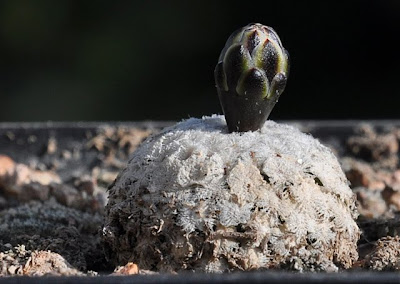
Normanbokea valdeziana about to flower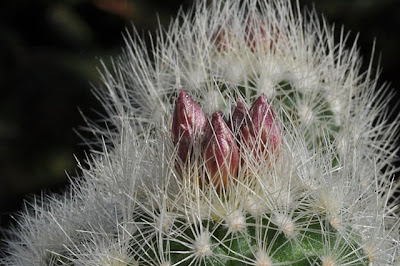
Acharagma roseana about to flower
Fortunately fruits are more persistent than flowers giving me the opportunity to enjoy sights like the orange-red berries of Escobaria missouriensis (Mesa County, Colorado; SB204)
Escobaria missouriensis with fruit
My Maihuenia patagonica are thriving after the winter but not exactly flowering or setting fruit. I don’t have much experience growing Maihuenia - I originally fell for Maihuenia poeppigii but being a completist I ordered M. patagonica seeds as well. All the M. poeppigii plants succumbed to the frost this winter while the M. patagonica plants only suffered a few casualties. I'm not sure I’m treating the plants right, though, as they are growing strangely lanky, far from the dense, clustering habit I have seen in pictures (and the plants are getting plenty of light).
Maihuenia patagonica
And now for something completely different.
My summerhouse is located on the west coast of Denmark overlooking the North Sea. This weekend the Sun set in a sky looking much more orange than usual, and slightly diffused as by a thin haze. 
The Sun setting in a haze of ashes from the Eyjafjallajökull eruptions
I take this to be caused by the Eyjafjallajökull volcano eruptions that have been sending a vast, invisible plume of grit drifting over Europe and kept most of European airspace shut down for several days. Of course one could imagine that a sunset like this was caused by a thin layer of clouds, but I have enjoyed hundreds of sunsets from my terrace and never seen anything like this before.
Sunset with a diffuse halo of refracted light – probably caused by Eyjafjallajökull ashes
On a different note, the Eyjafjallajökull volcano eruptions almost got me stuck in Amsterdam (not the worst place to be stuck in, by any means ;-) I and a colleague were supposed to have flown home in the late evening of April 15, 2010 – but as we watched more and more flights getting canceled and increasing parts of the north-western European airspace being closed down we agreed to rent a car. So in the early afternoon we set out on a long drive home – which in hindsight was an extremely wise decision as Danish airspace is only opening again today ;-)
Sunday, April 11, 2010
The killing frost – casualties and survivors
First a bit of background information so that you guys won’t believe that I am completely stupid growing Lophophora and the likes in an unheated greenhouse in Denmark: 1) Most of these plants are “surplus”, i.e. I don’t have room for them anywhere else – lately several plants have been bought specifically for the cold house, though. 2) The greenhouse is located at my summerhouse, left mostly desolate throughout winter, making it difficult to keep it reliably heated. 3) Many cactus species tolerate more frost than is generally assumed; I’m curious which. 4) The winters in Denmark have been rather mild lately, inviting experiments like this.
With this in place I’m ready to recount how the harsh winter, that has just released its cold grip of Denmark, helped me separate the wheat from the chaff (a blatant euphemism for “killing off alarmingly large parts of my collection”). Just to give an understanding of the severity of the winter, the plants saw almost constant frost for more than 10 weeks, with temperatures measured as low as -15 C (5 F) in the area where the plants grow.
Lophophora williamsii var. echinata coming out of winter
Let’s start with one of the success stories. My Trans-Pecos peyote plants are doing quite well, approximately one in eight died and the surviving plants are not too marked by the frost. The plants I'm growing are descending from material originally collected in the Pecos River area, Val Verde County, Texas (JJH 8608293). The Trans-Pecos peyote is the northernmost form of Lophophora williamsii and is also known as Lophophora williamsii var. echinata.
Trans-Pecos peyote surviving the frost
My regular (Mexican and south Texan) Lophophora williamsii plants fared much worse, less than one in ten of the larger plants survived the winter. 
One of the few surviving Lophophora williamsii var. williamsii
This corresponds well with Del Weniger’s observations:
[Lophophora williamsii var. echinata] can also survive the much more severe cold of the Big Bend. I have several times had the smaller form from south Texas [L. williamsii var. williamsii] freeze in San Antonio, while this form [L. williamsii var. echinata] growing in the same bed showed no ill effects.
In the future I'll focus more on the extreme northern forms of peyote, i.e. plants grown from material originating from Shafter, Val Verde, Big Bend and other Trans-Pecos, Texas locations. The Cactus Conservation Institute has an informative page on the differences in traits between Lophophora williamsii var. echinata and var. williamsii.

Frost killed Lophophora williamsii, Starr County, Texas
As mentioned the majority of my large “regular” Lophophora williamsii were killed by the frost. But many medium sized seedling plants actually survived while the larger plants (of the same variety) and yearling seedlings succumbed. As this pattern seems to be rather consistent for plants of the same variety, I guess I can’t write all “regular” Lophophora williamsii casualties off to genetics. My theory is that this “size-conditioned” difference in survival must be related to how well the plants were prepared for the winter, which again may be closely related to the surface-area-to-volume ratio of the plant.
The surface-area-to-volume ratio (SA:V) decreases with size, i.e. a large plant will have less surface per unit of volume than a smaller plant. If we use a half sphere as a model for a globular cactus we get a SA:V of 3/r, where r is the radius. Consequently a large plant will need relatively longer time (per unit of volume) to go flaccid and prepare properly for the winter (as all excess water needs to be evaporated through the surface (the epidermis)). Similarly seedlings are more prone to die of drought as an increased SA:V means increased exposure to the environment in general.
To play it safe the coming growing seasons I'll stop watering my large plants well before I let seedlings go drought dormant in preparation for the winter, and in general start winter preparations earlier than I have used to in the past.
I might consider crossing the surviving mature (non Trans-Pecos) plants and name the cultivar Lophophora williamsii 'Borealis' ;-)

Frost killed Leuchtenbergia principis – outside the rain is weeping
My largest Leuchtenbergia principis is dead (pictured above next to a surviving saguaro) while 3 out of 4 of my smaller Leuchtenbergia principis plants (GL 770; Sierra de la Paila) are looking happy.
Ariocarpus has turned out to be an unconditional coldhouse success. I expected my Ariocarpus fissuratus plants to make it safely through the winter as they originate from locations like Fort Stockton, Texas (JM 122) and Crockett County, Texas (SB 403), but I had doubts about my Ariocarpus kotschoubeyanus var. macdowellii plants (SB 100; El Pilar, Coahuila), and had accepted that I would probably loose my Ariocarpus retusus (SB 310; Cuesta la Muralla, Coahuila). Amazingly they all survived the winter in great style almost looking lush and vigorous, like a winter swimmer surfacing with renewed energy after a cold plunge.

Surviving Ariocarpus, Epithelantha, and Leuchtenbergia plants
Epithelantha is another seriously cold tolerant genus. My Epithelantha micromeris var. greggii plants (Cuesta la Muralla, Coahuila, Mexico) all made it; one is seriously damaged, though – it looks like the root is dead while the crown looks fine, so I hope to be able to re-root it. The Epithelantha bokei plants (SB 416; Brewster Co, Texas) also look fine, but due to the extremely dense spination it is hard to say for sure if they are completely undamaged. Strangely the cold has taken the hardest toll on my regular Epithelantha micromeris (SB1327; near Belen, New Mexico) – this variety of E. micromeris is from the northernmost known locality of the species so I had expected the plants to cope better with the frost.

Surviving Obregonia denegrii plants
Last summer I moved a handful of Obregonia denegrii seedlings (VVZ 163; San Vicente, Tamaulipas) to the coldhouse. I really didn’t expect these plants to be cold hardy, but didn’t have room for them anywhere else. Surprisingly approximately two thirds of the plants survived as illustrated in the above picture (the surrounding pots are not empty, each contain a rather large L. williamsii killed by the cold).
Other success stories are Normanbokea valdeziana, Homalocephala texensis, and Mammillaria meiacantha which all made it through the winter without casualties – the Normanbokea plants are even budding. Acharagma roseana is another species that’s shaking off the winter blues and getting ready to bloom – in general Acharagma seems to handle the cold pretty well, even most of my yearling Acharagma aguirreana seedlings survived. Most Escobaria and Echinocereus obviously had minimal problems with the frost.

Frost killed Lophophora williamsii turning to mush
As mentioned above the majority of my larger, regular Lophophora williamsii plants were killed by the frost, but the more tender Lophophora species like Lophophora diffusa and L. fricii are completely eradicated – I’ll probably not experiment further with these species in the coldhouse, the exception maybe being montane varieties of Lophophora fricii.

Dead Lophophora diffusa
Other species that are completely wiped out include Matucana madisoniorum, an unknown Echinopsis hybrid, Ferocactus glucescens (PP 1354), Lithops lesliei (not exactly a cactus, I know ;-), and Harrisia jusbertii. Surprisingly all my Mammillaria grahamii also died – I had expected this species to be more cold hardy.
Most of my saguaro cactus (Carnegiea gigantea) also succumbed to the frost – 4 plants look like they might survive, most of them badly damaged, but it is too early to say.
I need to start building a new collection of grafting stock – all Trichocereus plants that I grew in the coldhouse are dead, including Trichocereus pachanoi, T. peruvianus, Trichocereus 'Tom Juul’s Giant', and a Penis Cactus… they are all gone. Even plants that were well prepared for the winter died, so Trichocereus is definitely not as tolerant to frost as I had expected.
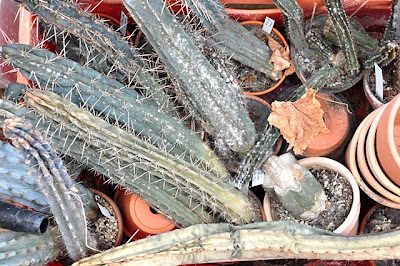
Decomposing Trichocereus plants
To put the death toll into perspective this is the coldest winter in 14 years in Denmark (followed by March, a month with the most extreme temperature fluctuations in 14 years, which were not very becoming to my struggling plants either). The frost set in just before Christmas and only lifted again in the beginning of March. The lowest temperatures measured in the area were as low as -15 C (5 F).

Outdoor temperature in late January
Once in a while short bursts of thaw set in quickly followed by frost (as indicated by the above graph), making the conditions even harder for the plants.

Outdoor temperature in mid February
The temperature measurements come from a semi-professional weather station located approximately 1.5 km (~ one mile) from where I grow my plants, so these temperatures are representative for those that my plants where exposed to.
To end on a positive note I expect the frost to have killed off many pests also (including red spider mites). Also, I got an affirmative confirmation that it is actually possible for peyote to survive rather extreme conditions in an unheated greenhouse in Denmark... and I got plenty of room for new plants ;-)
Sunday, March 21, 2010
Acharagma roseana – flowers and fruits
To be honest, Acharagma roseana plants are not particularly ingratiating – the flowers are not breathtaking nor is the spination stunning. To me, the attraction of A. roseana lies in its close relationship with Lophophora and Obregonia, making it an obvious candidate for hybridization experiments.
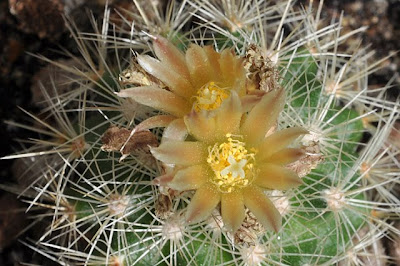
Acharagma roseana flower with pale yellowish tepals with brownish pink midveins
Gene sequence studies by Butterworth et al. (2002) suggest that Acharagma belongs in a well-supported taxonomic clade with Lophophora and Obregonia. They sum up their results as follows:
LOPHOPHORA CLADE. Although there is strong support for this clade (87% bootstrap, 5 decay steps), few morphological features unite this clade. All members have napiform or carrotlike tap-root systems, although these features are also found in other members of the tribe.
The two species of Acharagma have been a source of taxonomic confusion. […] The rpl16 intron data suggest the removal of these two species from Escobaria, placing them in a well-supported (bootstrap 87%, decay 5) clade containing Obregonia and Lophophora, the latter shown to be polyphyletic based on this topology.
(the closing remark on Lophophora being polyphyletic is an interesting statement in its own right, but that’s a whole other story)

Acharagma roseana flower with pink tepals with darker red-tinged midstripe
In The New Cactus Lexicon, Hunt describes this species as Acharagma roseanum - I’m not sufficiently well-versed in the Latin language to say which form of the name is correct, but according to this site on botanical Latin the specific epithet must match the genus name in gender. As Acharagma is from the Greek a, without, charagma, groove (the gender of which, according to Hunt, is neuter) this would warrant the “-um” ending. I’m a firm believer in applied laziness so I’ll stick to the (apparently erroneous) “-a” ending for a wee bit longer and avoid having to re-label my plants ;-) Hunt accepts two subspecies: ssp. roseanum and ssp. galeanense, the latter having more spines and slightly larger, cylindrical bodies, compared to the egg-shaped body of the typical form.

Comparison of the two different color forms of Acharagma roseana flowers
The Acharagma roseana plants featured in this post were started from seed in 2005 and flowered freely last summer. As mentioned I would like to use these plants for hybridization experiments with Lophophora but I still need to come up with a good protocol for avoiding self-pollination. The locality information for these specific plants is: LX 578; Ramon Arizpe, Coahuila - “Ramon” should probably read “Ramos” but I'll stick to the information from the vendor’s seed list.

Acharagma roseana with fruits
Like most other parts of Acharagma roseana the fruits are not showy either. They are an inconspicuous yellowish green color, but have a surprising, not unpleasant, tart taste reminiscent of gooseberries.
The plants grow in my unheated greenhouse and I hope they survive the month long cold snap that is just now loosening its grip of Denmark.
Thursday, April 23, 2009
Spring awakening in the coldhouse
All of the photos in this post were taken at the beginning of April to illustrate some of the spring activity in my coldhouse. The plants have been kept dormant all through winter and received their first drink of water only a few days before these pictures were shot.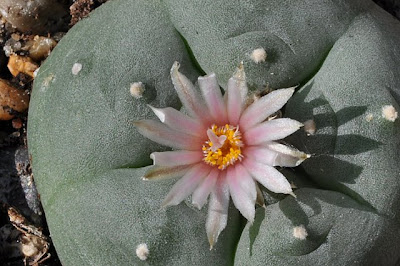
Flowering Lophophora williamsii (El Huizache, San Luis Potosí)
The first plant I want to show off is a flowering Lophophora williamsii grown from seed originating from the El Huizache, San Luis Potosí, Mexico population (the population Anderson assigned as the neotype for the species). These plants are from a more southerly location than the ones I'm usually growing and I'm happy to see they are coping so well with the cold conditions during winter. I was getting used to thinking of all L. williamsii varieties as self-fertile but according to the Cactus Conservation Institute, greenhouse breeding experiments by Bohata and colleagues in the Czech Republic and by Köhres in Germany have shown that plants from the El Huizache population are self-sterile and therefore obligate outcrossers (leading one to suspect a great deal of genetic diversity within plants from this population – in contrast to the self-fertile populations that have little to no genetic diversity among individuals as they outcross very little). 
Lophophora williamsii (El Huizache) flower with long style
The flowers of the El Huizache plants also seem to have a very long style that raises the stigma well above the stamens, making it hard, if not impossible, for the plants to reproduce without the help of a pollinator.
Bumble bee having fun with a Lophophora williamsii flower
Speaking of pollinators a bumble bee visited while I took these pictures – unfortunately only this one Lophophora flowered at the time making it impossible for the bee to fertilize the plant. The bumble bees that are active in early spring are huge; I don't know much about bees but am told that these large slow individuals are queen bees looking for nectar and pollen to feed their newly hatched brood.
Lophophora williamsii (SB 854; Starr Co, Texas) with fresh fruit
One of the Lophophora williamsii (SB 854; Starr Co, Texas) plants that I recently repotted has spawned a fruit. This variety of Lophophora williamsii is self-fertile to an extent where it happily sets seed if you just shake the flower a bit.
Flowering Acharagma roseana (LX 578; Ramon Arizpe, Coahuila)
My Acharagma roseana plants (LX 578; Ramon Arizpe, Coahuila - “Ramon” should probably read “Ramos” but I'll stick to the information from the vendors seed list) are coming of age. The plants were started from seed 4 years ago and are all ready to flower, displaying a wealth of flower buds. Only one, shown in the picture above, flowered when I took the pictures. Unfortunately it will be a while before I can visit my summerhouse (and coldhouse) again – I hope at least a few of the flowers will be saved for then. My Echinocereus reichenbachii plants are also growing a multitude of buds, getting ready for a flower fest I would hate to miss.
Frost damaged Matucana madisoniorum
Until now I have focused entirely on the success stories but a few of my plants didn't like being without heat during winter. My Matucana madisoniorum definitely didn't like the cold conditions (even being wrapped in multiple layers of horticultural fleece). The plant is heavily marked by the experience but survives.
I also lost a few plants: a couple of Carnegia gigantea (saguaro cactus), a Cylindropuntia bigelovii (teddy-bear cholla), and a Cylindropuntia tunicata (thistle cholla); I managed to save cuttings of the chollas though. These plants were kept out on the terrace all summer and I probably left them out for too long, exposing them to the autumn storms so the plants were not able to dry out completely before winter. I'm especially sad about the Carnegia gigantea plants as they were great specimens and are now completely reduced to mush.
Tuesday, May 23, 2006
Lophophora and Epithelantha - experiments in cold hardiness
According to common belief, species from Lophophora, Epithelantha, Ariocarpus etc, do not like subfreezing temperatures. This is not entirely true - many varieties will survive temperatures dropping well below freezing. The last couple of years I've experimented with growing Lophophora, Epithelantha, and Acharagma in an unheated greenhouse, and this winter the plants had to endure temperatures below -10C (14F) for extended periods. I'm planning on growing Ariocarpus as well if I can find seeds originating from the Trans-Pecos area.
Lophophora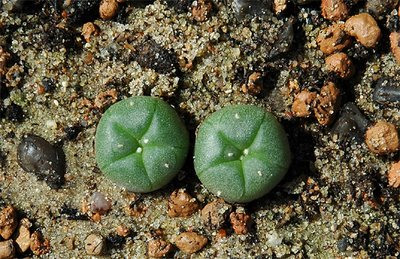
Lophophora williamsii – started from seed 2004
The picture above shows Lophophora williamsii (SB 854; Starr Co, Texas) plants sown May 1, 2004. After 2 years in the coldhouse the plants are thriving - more plants have been disfigured and killed by bush-crickets and other critters than by the cold. The remaining 5 plants are each 1.5 cm (~ 0.6'') wide.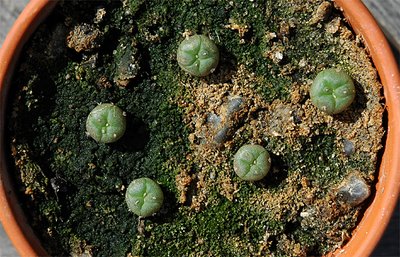
Lophophora williamsii – started from seed 2005
Last years batch of Lophophora williamsii (SB 854; Starr Co, Texas) seedlings are also doing well. The 5 plants have obtained a diameter of 1 cm (~ 0.4'').
The more southern living Lophophora diffusa is not handling the cold as well - none of the plants started from seed in 2004 are left, and only 2 plants from the 2005 crop are still surviving. The L. diffusa seeds originated from plants from Higuerillas, Queretaro. The 11 Lophophora decipiens seedlings from last year are doing slightly better, but as the L. diffusa seedlings they have only grown to a width of 0.5 cm (~0.2'').
Epithelantha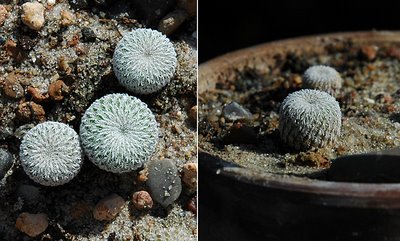
Left: E. micromeris v. greggii (Cuesta la Muralla, Coahuila)
Right: E. micromeris (SB 1327, near Belen, New Mexico)
I'm growing Epithelantha micromeris v. greggii (Cuesta la Muralla, Coahuila) and Epithelantha micromeris (SB 1327, near Belen, New Mexico). The New Mexico variety is a slow grower – the 12 plants are less than 1 cm (~ 0.4'') wide – but it is handling the cold very well. The Coahuila variety is growing faster but is more susceptible to frost damage – the 11 plants are each 1.5 cm (~ 0.6'') wide. All plants were sown May 1, 2004.
Acharagma
The Acharagma aguirreana (RSM 396; Sierra Paila, Coahuila) and Acharagma roseana (LX 578; Ramon Arizpe, Coahuila) seedlings from last year are still fairly small – less than 0.5 cm (~0.2'') in width. A. roseana seems to be better at tolerating frost than A. aguirreana; I sowed 30 seeds of each species, and 20some seedlings of each germinated. Today more than 20 A. roseana are surviving while only 3 A. aguirreana are left.
Saturday, May 14, 2005
Sowing in the rough
If I don’t chicken out, the plants growing from the seeds sown today are going to spend the rest of their lives in an unheated greenhouse in Denmark. 30 seeds of each of the below species were sown.
- Acharagma aguirreana (RSM 396; Sierra Paila, Coahuila)
- Acharagma roseana (LX 578; Ramon Arizpe, Coahuila)
- Lophophora williamsii v.decipiens
- Lophophora williamsii (RS 268; Huizache, San Luis Potosí)
I also sowed some leftovers from last year. 10 seeds each of:
- Lophophora diffusa (JR; Higuerillas, Queretaro)
- Lophophora williamsii (SB 854; Starr Co, Texas)
A cold house batch of the two latter species was also sowed last spring. Most plants survived the winter and are now resuming growth.
| next >
All Time Most Popular Posts
-
Lophophora williamsii (peyote) populations have diminished in large areas of South Texas where peyoteros harvest the cactus for ceremonial ...
-
On various occasions I've been asked what growing media I'm using for my cactus plants. I don't have a set soil mix recipe as su...
-
Below is a list of retailers/nurseries selling cactus seed and plants. I've only listed vendors I've done business with. If you ar...
-
Most cacti are easily grown from seed - and with a little patience and care they can be grown into beautiful plants. Lophophora williamsi...
-
In last month’s post on the troubled Texan peyoteros I referred to Anderson’s article on the peyote situation in Texas. Given the importanc...
-
Yet another slightly off topic and probably not entirely politically correct post, but I couldn’t help noticing the similarity of my monstr...
-
Flowering stand of San Pedro cacti (Trichocereus pachanoi) To me the main draw of the San Pedro cactus ( Trichocereus pachanoi (syn. Ech...
-
In the June 2008 issue of the Cactus & Co magazine Jaroslav Šnicer, Jaroslav Bohata, and Vojtěch Myšák described a new Lophophora spec...
-
There seems to be an increased focus on the alarming Texas peyote situation. A couple of weeks ago the Houston Press published a mournful, i...
-
I spent two weeks working in Delhi, India during January. I had one weekend off and had planned to spend it in Delhi at my own leisure, but ...
